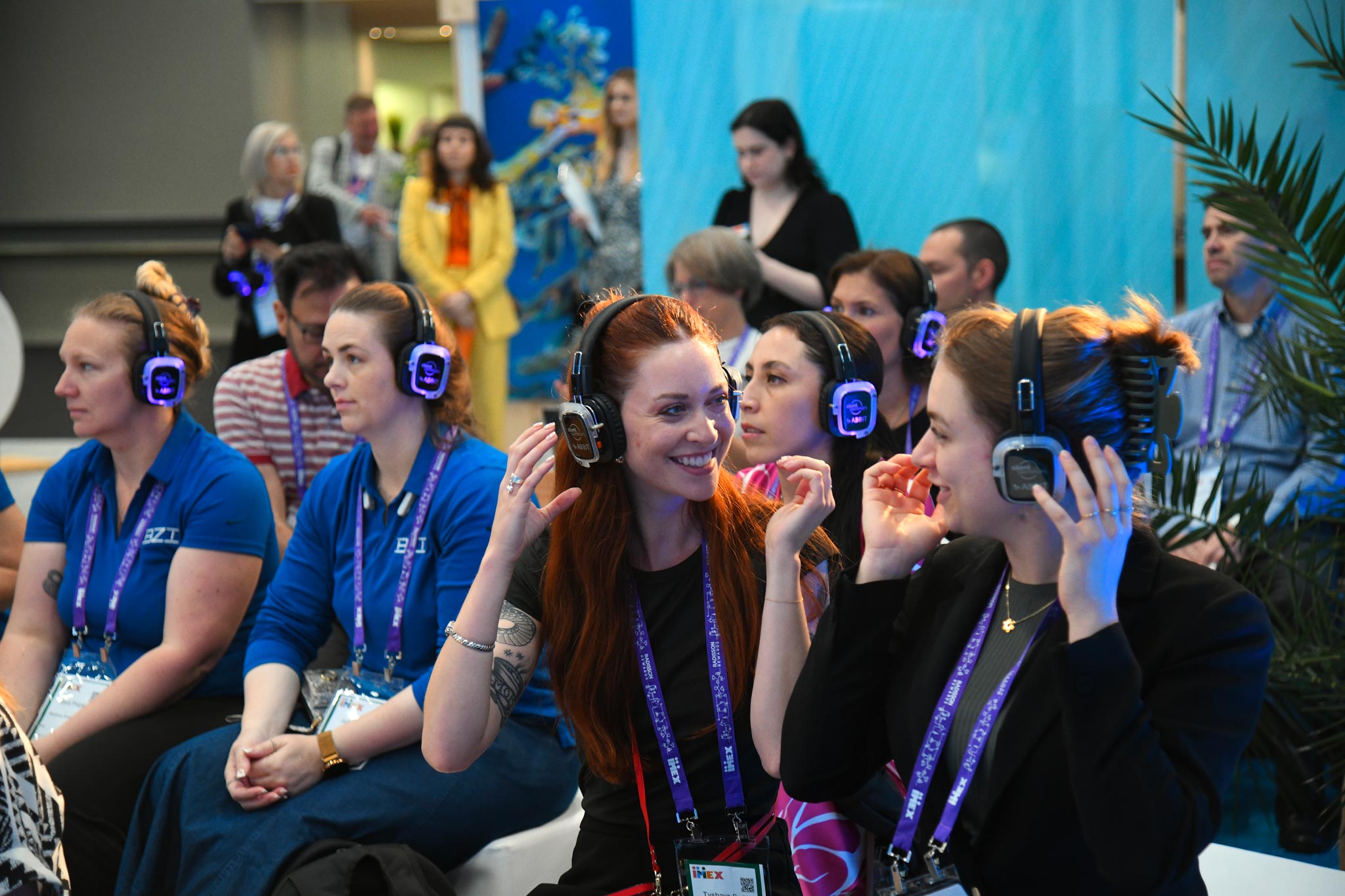Soon enough, face-to-face events will be a part of our lives once again. However, setting these experiences up will require a new tact. Here is how we think the return of face-to-face live events will look. It is no secret that we are excited to see face-to-face experiences coming back into play. However, after a year and a half of adapting to the Covid-19 pandemic, we must ask ourselves what should be considered when creating future experiences.
We are used to connecting through screens. While the technology existed before the pandemic, 2020 thrust names like Zoom and Teams into our daily schedules as our industry scrambled to adapt to the new rules of engagement. Now that we have adapted, the question we must ask is how we should return to face-to-face experiences?
Are we going back completely? In short, the answer is no, at least not for the entire industry. The digital engagement opportunities we found during the pandemic were discovered out of necessity, but that doesn’t mean that we will be turning our backs on them in the future. Going digital helped towards solving our client challenges like budget, timing, and access.
Professionally and personally, our tech has allowed us to stay connected with ease, kept us informed, and helped deal with being locked down. It would be naïve to assume that these avenues for connecting audiences will disappear upon returning to the new normal.
One thing to bear in mind is something that we undoubtedly have all experienced is digital fatigue. With so much of our time spent in front of our devices, there have been overwhelming reports of fatigue, lack of attention, and lapses in interest when experiences are formatted solely on digital platforms.
Since our devices have been our primary form of connection and escapism recently, time spent in front of screens should be crucial when designing an experience.
Soon, we will see hybrid elements playing a huge role in events. The pandemic fast-tracked the move towards the combination of analogue and digital elements within events. This shift will unlock new engagement streams and overcome critical challenges that haunted events in years gone by.
Here is an example. When expanding your audience base, there is a high chance of those audiences hailing from different time zones. Hybrid helps us solve this challenge by splitting our event into different time zones, staggering the content and helping to create a better shared virtual experience.
However, it is essential to remember that although engagement streams can be separated using technology, it does not mean that your event will be disjointed. You will be able to segment your content into digestible and focused portions and even target the most relevant sections to their respective locations. Hybrid is about increasing audiences, not dividing them.
When pivoting events to a more hybrid-focused design, we must re-evaluate what you can sell your experience on. This is one of the critical considerations that must be taken into account from now on. Previously, we promoted events on keynote speakers and special guests attending, but a new environment always calls for a new approach.
An exciting part of hybrid events is the shift in how your audience engages with your event and the boosted attendance through digital audience streams. But this may come with the added challenge of finding new ways to draw people in.
There is a new way to make experiences live long after the physical event has ended by using hybrid solutions. By factoring in digital communications for before, during, and after the event, the opportunities for education, excitement, and networking can be tremendous.
It is up to us all to utilise this technology, design our audience journey from the very start, and reap the benefits from the hybrid.
“Hybrid is about increasing audiences, not dividing them”
What we may even see in the future is an emergence of new platforms that allow you to stay connected with your audiences and keep the conversations going. In the return of face-to-face, we expect to see experiences starting in emails, moving to expo halls, and finishing on personal devices.
When you bring the best elements of virtual and analogue experiences together, you truly create an environment for success. The right hybrid solutions can open up new avenues for engagement, education, and ultimately, revenue.
Over a year later, with the cancellation or postponement of face-to-face events and the transition to virtual, the expectations and needs of sponsors and partners have changed. The commercial offer of learned associations and societies had to be adapted accordingly to meet them best.
This transition has been greatly accelerated with the health situation. The partners have dealt with more than expected with the modalities of virtualisation of their participation, sometimes within very short deadlines.
Regarding long-term commitment, ROI, and innovative strategies, I asked for input from our global MCI experts to share their experiences.
The expectations of sponsors have radically changed in the digital space. How do we ensure that these expectations are met?
Some were not ready for the virtual transition, so it was necessary to accompany them and reassure them throughout their preparation. MCI decided to involve and engage partners in a more global reflection on their experience of hybrid and, or virtual, on the future of events and their positioning with associations.
This study made it possible to highlight that many of them do not calculate their return on investment (ROI) because they do not have tools or methods available, or they do not have the necessary time.
The digitisation of events has enabled some partners to assess this ROI thanks better to easily quantifiable data. Soon, hybridisation will also make it possible to provide face-to-face ROI assessment tools and methods, which was more difficult to calculate in the past.
One of our missions as a consulting partner is to convince associations of the importance of ROI for their partners. Beyond supporting associations, partners must justify the investment made. If this investment is profitable, then the association will be able to retain them and ensure the sustainability of its income more easily.
With event virtualisation, sales processes have accelerated. What impact does this have on the events of associations and societies?
With virtual, the income related to registrations is considerably reduced (and sometimes even free). The sponsorship of events, therefore, has an increasingly important role in the financing and survival of the event.
Before transforming an event, you have to study all its aspects. This exercise is essential because it will influence the time of communication, prospecting and sales. To reassure the partners, we take time with each of them.
There is a setup of explanatory videos or webinars for partners to have all the cards in hand to boost their virtual space and be operational on the proposed virtual platform. In a reasonably short time, you have to be very efficient. This considerably reduces the prospecting time.
Marketing budgets have been reduced, and, as a result, sponsors are forced to rethink their investment strategies. How do you help your clients adapt their packages? What innovative strategies have you put in place to guarantee the ROI?
In times of crisis, marketing budgets are traditionally the first to be cut. However, the need to reach new customers, generate leads, find opportunities is stronger than ever. For this, each marketing investment must be relevant, objectified, profitable and measurable.
Our first action is to generate in-depth knowledge (interviews, polls, surveys, etcetera) of the specific needs of each major sponsor. We can then support our association clients in redesigning their offer in an “à la carte” spirit.
“A new environment always calls for a new approach … Staying relevant takes creativity”
The second step is the monitoring and optimisation of the ROI of each sponsor via a “ROIste” consulting/coaching offer intended for the sponsors. In this, digital offers endless possibilities. In face-to-face and hybrid, the in-depth knowledge of sponsors and visitors allows us to ensure that the right offer meets the proper demand.
What strategy can be adapted to maintain the long-term commitment of sponsors and exhibitors through virtual or hybrid events?
The virtualisation and hybridisation of events are significant upheavals in the exposure habits of sponsors, who suddenly have to revisit a copy that had never been imagined other than face-to-face.
The strategy for maintaining the long-term commitment of sponsors and exhibitors is to involve them in the event virtualisation process. The virtualisation and hybridisation of events are significant upheavals in the exposure habits of sponsors, who suddenly have to revisit a copy that had never been imagined other than face-to-face. They should not feel like spectators (or worse, hostages) of the transformation but rather coconstructors of this new participation formula.
By consulting them on the various key phases in the development of the offer and the platform, as well as by training them on the use of new tools so that they understand how it works upstream of the event, the sponsors will feel involved as a stakeholder and no longer just as a user.
A better understanding of the measurement of the ROI of sponsors is also one of the keys to their long-term commitment. Qualifying visitors exhaustively will allow exhibitors to use comprehensive statistics and optimise the cost/contact ratio, one of the driving forces behind participation in a congress.
So, what will the sponsorship landscape look like in 2021 and beyond?
According to MCI, sponsorship in 2021 and beyond will continue to evolve towards a collaborative partnership model. We were on the path to this evolution, but Covid-19 accelerated the process. Staying relevant takes creativity.
Exchanges between potential sponsors and affiliated organisations should be anchored in collaboration, listening to needs and analysing performance. If content is king, data is queen, and together they open the door to levers of opportunities for associations and sponsors.
The way forward, however, is not straightforward. It requires strategic planning, creativity and a willingness on all sides to explore and push the boundaries of their collaboration.
The codevelopment of educational content, the colocation of affiliate programmes, the optimisation of digital marketing, the volume effect, hybrid mechanisms, the extended lifespan of the content, the engagement of targeted populations, ROI, data analysis and reporting are among the many topics that must be addressed in the design of new partnership offers.
This is to establish a broad, dynamic and relevance-based collaboration to achieve the objectives of the association and the sponsors.



